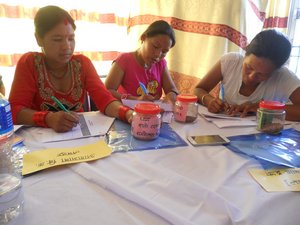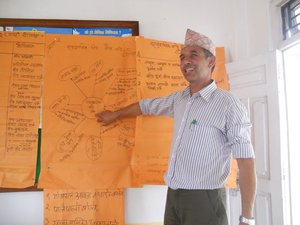Farmers get to work to establish vital community seedbanks in Nepal

After two earthquakes devastated parts of Nepal one year ago, Devendra Gauchan, National Project Manager and Bhuwon Sthapit, Senior Scientist, Bioversity International, send their fourth report on a training programme to establish much-needed community seedbanks in the Himalayan region.
One year after two devastating earthquakes killed and injured thousands of people, destroying homes, food and seed stores, Devendra Gauchan, National Project Manager and Bhuwon Sthapit, Senior Scientist, Bioversity International, send their fourth report from Nepal on a training programme recently carried out in four districts in the Himalayas to establish much-needed community seedbanks.
In earlier reports, we spoke about the urgent need to replenish seed stocks which had been lost or damaged in the remote regions of Nepal that depend on agriculture for food and income. We also explained why the farmers must become part of the selection and evaluation process and how Bioversity International and partners are using a crowd-sourcing approach to understand farmers’ preferences for varieties in four project sites as part of the disaster recovery effort, and how the Seed Recovery Programme is working with farmers in 10 of the 14 most-affected districts to rescue and safeguard rare native seeds. Now we turn our attention towards establishing community seedbanks that are vital to safeguard locally-adapted genetic diversity for future food security in this area.
Access to locally adapted seeds from formal seed systems is very much limited in these remote mountainous regions of Nepal. This is why community seedbanks are so important to encourage and strengthen local seed systems, to conserve biodiversity and to promote production and value addition of traditional mountain crops. The four districts – Dolakha, Lamjung, Jumla and Humla – each represent the different rain-fed regimes of Nepal's mountain areas, and contain a wealth of unique local crop diversity bringing unique genetic traits that are vital when it comes to food security, for example, growing in poor soils, adapting to climate change, or resisting crop pests and diseases.
 To this end, a 3-day participatory training program was offered by the Local Crop Project, facilitated by Bioversity International, LI-BIRD and scientists from the National Gene Bank. The training was held at the Agyeuli Community Seedbank Office. This community seedbank contributed around 10 tons of seeds to earthquake-affected communities as seed relief during last year’s disaster, and provided an ideal location for the training, as farmers and project staff were able to directly observe and learn about the structure, operational procedures and seed management activities. They were also able to interact with other local farmers to discuss how to establish and manage their own seedbanks in the near future. Farmers in the Dolakha site, for example, showed a strong commitment to starting the construction of a community seedbank within the next two or three months in their own land. In total, 25 participants including farmers and project staff from four project sites participated in the training. Senior project team members and other staff also participated, bringing contributions from their own experience, which enriched the training.
To this end, a 3-day participatory training program was offered by the Local Crop Project, facilitated by Bioversity International, LI-BIRD and scientists from the National Gene Bank. The training was held at the Agyeuli Community Seedbank Office. This community seedbank contributed around 10 tons of seeds to earthquake-affected communities as seed relief during last year’s disaster, and provided an ideal location for the training, as farmers and project staff were able to directly observe and learn about the structure, operational procedures and seed management activities. They were also able to interact with other local farmers to discuss how to establish and manage their own seedbanks in the near future. Farmers in the Dolakha site, for example, showed a strong commitment to starting the construction of a community seedbank within the next two or three months in their own land. In total, 25 participants including farmers and project staff from four project sites participated in the training. Senior project team members and other staff also participated, bringing contributions from their own experience, which enriched the training.
Each farmer was asked to bring their own seed samples of a local variety as part of the training exercise. They learned about the specific traits of local seeds from traditional crop landraces, sharing knowledge with each other and learning how to document them, including procedures to conserve their seeds in community seedbanks. They also gained a better understanding of the resources and facilities needed to operate community seedbanks, and how to mobilize local community-based institutions and develop networks with district-level government organizations, NGOs, research institutions and the National Gene bank, for technical and financial support.
 During the training programme, participatory sessions were organized to jointly develop and discuss site-specific work plans. It also covered community-based management of locally-adapted seeds through blending traditional and scientific knowledge and the introduction of new storage and conservation technologies. A special focus was given to strengthening social mobilization skills and promoting local institution-building of communities to establish and sustainably manage community seedbanks in remote mountain sites.
During the training programme, participatory sessions were organized to jointly develop and discuss site-specific work plans. It also covered community-based management of locally-adapted seeds through blending traditional and scientific knowledge and the introduction of new storage and conservation technologies. A special focus was given to strengthening social mobilization skills and promoting local institution-building of communities to establish and sustainably manage community seedbanks in remote mountain sites.
As the programme was participatory, not only did the farmers learn the skills, but they were able to develop their own action plans to establish and manage community seedbanks in their villages. Mr. Gyan Jirel, a farmer from Jugu, Dolakha, says he now understands their importance and added that he had learned that:“we need to have community seedbanks to get our preferred seeds of locally adapted varieties at planting time”. Similarly, Mrs Rudra Maya Gurung, a farmer from Ghanapokhara village, Lamjung, said that she gained very useful knowledge about the importance and process of conserving native endangered seeds. “I will share what I have learned with local farmers, friends and relatives in my village after returning home”, she added.
Although there is still constant follow-up, interaction and technical support to be provided to all project farmers and communities, we expect that by the end of this year there will be more concrete results from the Nepalese project sites.
Devandra Gauchan and Bhuwon Sthapit
The training programme was carried out by Bioversity International, Local Initiative for Biodiversity Research and Development (LI-BIRD) and the National Agricultural Research Council (NARC). This work is part of the GEF/UNEP/Bioversity Local Crop Project: “Integrating Traditional Crop Genetic Diversity into Technology: Using a Biodiversity Portfolio Approach to Buffer against Unpredictable Environmental Change in the Nepal Himalayas” implemented in Nepal in partnership with NARC, LI-BIRD) and the Department of Agriculture (DoA).
Read the earlier reports from Nepal:
Part One: Matching seeds to needs in the aftermath of the Nepal Earthquake
Part Two: Deploying crowdsourcing and seed diversity in disaster recovery efforts in Nepal
Part Three: Safeguarding native seeds and rebuilding local seed systems in the aftermath of the Nepal earthquakes
Photo top: Participants in Community Seed Bank Training, Agyeuli, Nawalparasi, Nepal. Credit: N. Pudasaini/LI-BIRD
Photo middle: Women farmers from Lamjung documenting traits of landraces seeds as part of the training. Credit: D. Gauchan /Bioversity International
Photo bottom: A leader farmer from Jugu, Dolakha presenting linkage strategy for Community Seedbank. Credit: D. Gauchan/Bioversity International
